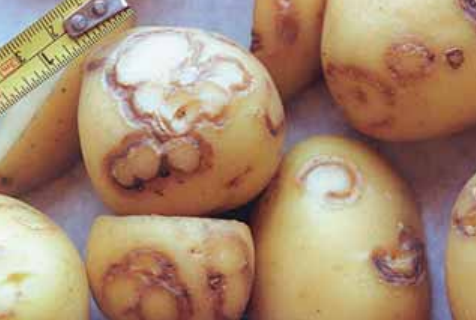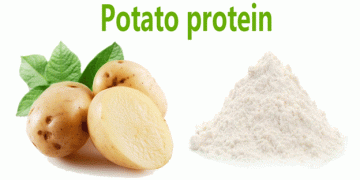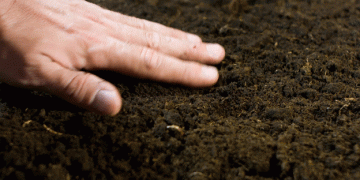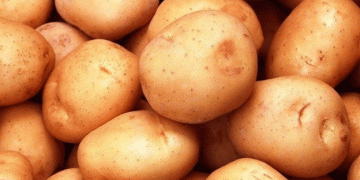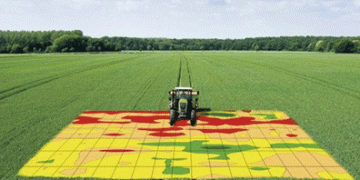Quarantine pests are regulated to avoid their introduction to areas where the pests are not present.
The Canadian Food Inspection Agency (CFIA) has the authority to take action on any of the pests considered to be quarantine pests to Canada.
Some important quarantine pests of potatoes are:
- Potato wart fungus
- Brown rot bacterium (race 3, biovar 2)
- PVYn and PVYntn viruses
- Columbia root-knot nematode
- Golden and Pale cyst nematode
LABORATORY ANALYSES ARE REQUIRED FOR THE POSITIVE IDENTIFICATION OF A QUARANTINE PEST.
Potato Wart (Synchytrium endobioticum)
❚ Pathogen. The potato wart fungus persists in the soil for up to 30 years as resting spores (sporangia). The spores may be introduced to healthy fields by infected seed and by farm equipment carrying infested soil. Manure from animals fed with infested potatoes will also spread the resting spores.
❚ Disease development. Cool, rainy weather favours disease development. In the spring, the resting spores reease zoospores, which are able to move in soil water
to reach and infect tubers, stolons and stems. After infection, the fungus produces a structure that releases more zoospores. These zoospores infect neighbouring
healthy cells. This cycle of infection and zoospore release may repeat several times during the season. Infected and surrounding cells enlarge or undergo rapid division, forming galls. Under stress conditions, zoospores may fuse in pairs and infect potatoes to form winter sporangia. Winter sporangia contaminate the soil as galls decay.
❚ Symptoms. Wart galls form on tuber eyes, on the stolon bud and on stem tissue, including the base of the stem. Occasionally, warts may develop on leaves,
flowers and the upper sections of stems. There may be a reduction in plant vigour.
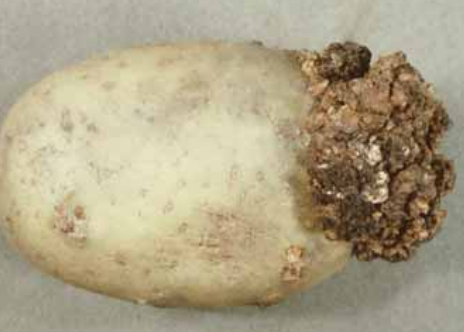
Tuber severely infected with potato wart. The entire tuber often becomes warty. Warts are not solid, but have a soft and pulpy texture.
PVYn, Tobacco Veinal Necrosis Strain of Potato Virus Y
Pathogen. The virus persists in potato tubers. Volunteer plants produced from infected tubers left in the field after harvest are a source of the virus as
well. Potatoes, tobacco and ground cherry weed are the main hosts. PVYn is identified in the laboratory using serological tests and in the greenhouse by symptoms on inoculated tobacco plants.
❚ Disease development. Several aphids can spread PVYn on potato fields, but the green peach aphid is the main vector.
❚ Symptoms. Although symptoms are rare, yield reductions of up to 30% may occur. PVYn is very destructive to tobacco.

Symptoms of PVYn on potato plants are rare.
Some varieties develop symptoms similar to mosaic. This symptom has also been associated with PVYntn.
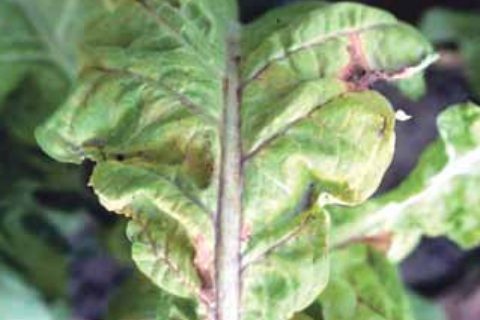
Foliar symptoms of PVYn on tobacco leaf.
PVYntn, Potato Tuber Necrotic Ringspot Strain of PVYn
❚ Pathogen. The virus persists in seed potato tubers and is spread by aphids.
❚ Symptoms. On tubers, PVYntn causes superficial necrotic rings that protrude slightly from the skin. Symptoms appear around harvest and the disease
develops rapidly in storage for the next three to eight weeks.
The development of symptoms requires warm temperatures in the latter stages of growth in the field and in storage. Infected tubers may be symptomless if temperatures are low. PVYntn may also cause severe chlorotic mosaic in leaves. PVYntn can sometimes overcome resistance on varieties that are resistant to potato virus Y.
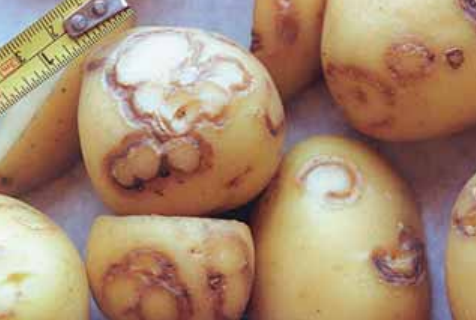
Tubers with more than one necrotic ring on their surface.
Brown Rot, Bacterial Wilt (Ralstonia solanacearum, race 3-biovar 2)
❚ Pathogen. Ralstonia solanacearum (Rs) is a bacterial plant pathogen that has a very wide host range. Rs has been classified into various races and biovars. Most races of the bacterium, and their associated diseases, appear to be limited to tropical, sub-tropical and warm temperate climates, and thus would pose no long-term threat to agriculture in cool temperate climates.
However, one particular race of the bacterium, termed race 3-biovar 2, or the “potato race,” is not known to occur in the United States or Canada. In recent years, it
has been found in some temperate areas of Europe, mainly on potatoes but also on tomatoes and a few weed species. This race of the bacterium is now considered a quarantine pest in Europe, Canada and the United States. The potato race has a narrow host range. It infects potatoes, geraniums, tomatoes, eggplants, peppers
and nightshade weeds. Bittersweet nightshade has latent infections. The bacterium can be soil- and seed-borne. It survives poorly in the absence of water. Contaminated irrigation water may also be a significant source of infection.
❚ Disease development. Although high temperatures and high soil moisture favour the development of Rs, race 3-biovar 2 is more pathogenic at lower temperatures. It invades a plant mainly through injured roots. Once inside the plant, the bacteria multiply and move to the vascular tissues. Infection eventually leads to wilting of the plant as the xylem vessels get blocked by the bacterium. The end result is plant death. Bacteria can move from the roots of infected plants to the roots of nearby healthy plants.
❚ Symptoms. Brown rot causes foliage to wilt rapidly. A stem cross-section usually reveals vascular browning. The eyes and the vascular tissue of infected tubers
appear greyish-brown.
Glistening beads of bacterial slime ooze freely from the vascular tissue of freshly cut stems and tubers. A sticky exudate may form at tuber eyes or at the stem end of
the tuber. Soil sticks to the tuber where bacterial slime has emerged. Brown rot and ring rot have similar symptoms, and a laboratory test is necessary for a definitive identification.

Upper leaves wilt during the heat of the day, but recover at night. This is usually followed by permanent wilting and the death of the plant.
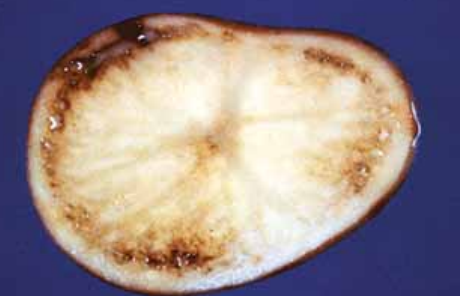
The vascular ring shows a grey-brown discolouration. A pale bacterial slime oozes freely from the diseased tissue.
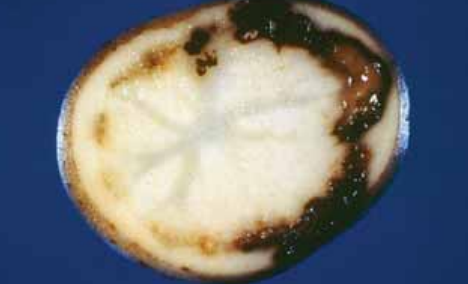
| In severely infected tubers, the rot extends beyond the vascular tissue.
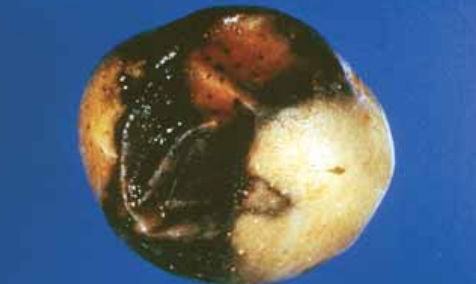
External appearance of a tuber severely infected with brown rot. Often, bacterial ooze exudes from the eyes and stem end.
